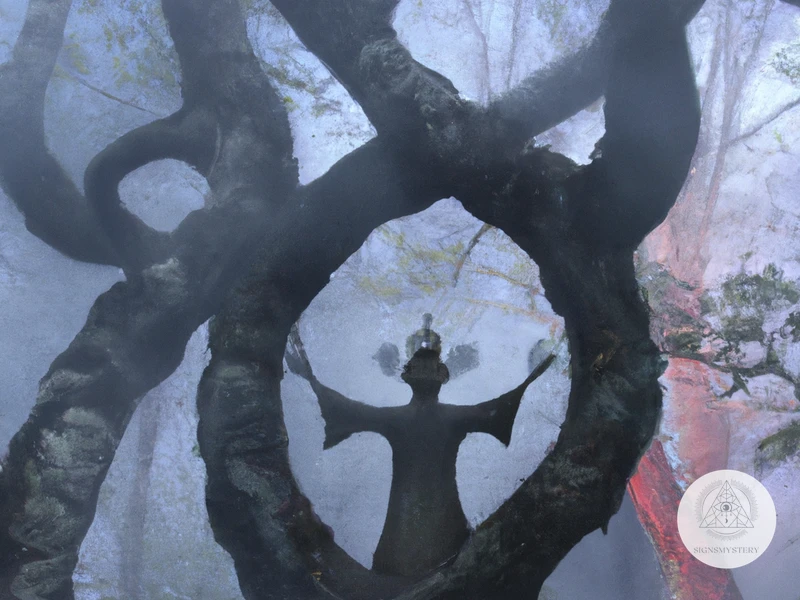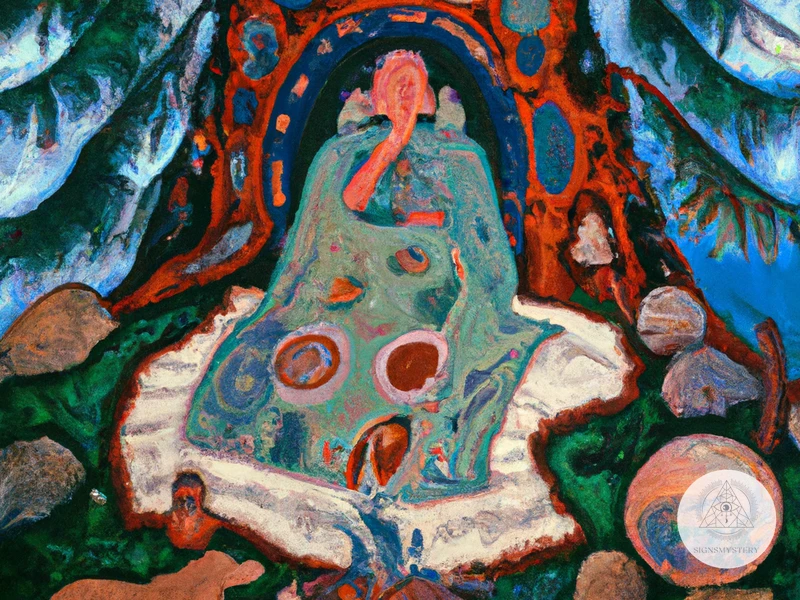Shamanism is an ancient spiritual practice that has gained increasing popularity in recent years. However, the mainstream shamanism we know today comes in two forms – Traditional Shamanism and Neo-Shamanism. While they both originated from the same spiritual roots, there are key differences in their beliefs, practices, and communities. As an assistant, I have written this article to provide a clear understanding of the differences between Traditional and Neo-Shamanism. We will also explore the similarities and impacts of Neo-Shamanism on the spiritual community. So, let’s dive deep and unravel the mysteries behind this fascinating practice.
What is Shamanism?

Shamanism is an ancient spiritual practice found in various cultures around the world. It involves a shaman, a spiritual leader or healer, who communicates with the spirit world to solve problems affecting individuals or the community. Shamans are believed to have the ability to connect with the spirits of ancestors, animals, and supernatural beings to gain insight into the causes of problems or illnesses. The shaman’s role in the community is to maintain spiritual balance and harmony. Shamanism also involves the use of rituals, ceremonies, and natural remedies to promote physical and emotional healing.
Traditional shamanism is the original form of shamanism, developed in indigenous cultures and passed down through generations. It involves a deep connection with the natural environment and beliefs in ancestor spirits and animism. Traditional shamans often use music, chanting, and dance as part of their rituals, and they rely heavily on their own spiritual experiences and intuition. The role of the shaman in traditional shamanism is integral to the community, acting as a mediator between the physical and spiritual worlds.
Neo-shamanism is a modern interpretation of shamanism that emerged in the western world in the second half of the 20th century. Neo-shamanism combines elements of traditional shamanism with new age spirituality and self-help practices. Neo-shamans often use tools such as drums, rattles, and crystals, and ceremonies may include guided meditation and visualization. The role of a neo-shaman is more individual-centered, with the focus on personal growth and spiritual development. Neo-shamanism is accessible to anyone interested in exploring spirituality, regardless of cultural background or ancestry.
Neo-shamanism is sometimes considered controversial because it is not based on a specific cultural tradition and can be seen as culturally appropriative. However, many proponents of neo-shamanism argue that it is a valid spiritual practice that can provide healing and personal growth for individuals who may not have access or connection to traditional shamanism.
Traditional Shamanism
Traditional Shamanism is a spiritual practice that has been around for centuries and is still practiced in some indigenous cultures. Shamans are considered intermediaries between the spiritual realm and the physical world. They use a range of techniques, such as chanting, drumming, and dancing, to enter altered states of consciousness and communicate with spirits. Traditional shamans also have a deep connection with nature and use plants in their healing practices. While traditional shamans differ in beliefs and practices, some common elements include a focus on community and an emphasis on spiritual guidance. To learn more about the contrast between traditional and modern shamanism, check out Neo-Shamanism: Evolution and Principles of Modern Shamanism.
Neo-Shamanism
is a modern adaptation of traditional shamanic practices. It emerged in the Western world during the 20th century as an attempt to revive and reinterpret shamanism for contemporary spiritual seekers. Although it has some similarities to traditional shamanism, there are also some significant differences.
One of the main characteristics of neo-shamanism is its individualistic approach: it emphasizes personal growth, self-discovery, and self-empowerment. Practitioners of neo-shamanism tend to see shamanic practices as tools for personal transformation and spiritual evolution. They often adopt practices like shamanic journeying, meditation, visualization, and energy work to connect with non-ordinary reality and access spiritual guidance.
Neo-shamanism also places a greater emphasis on a structured approach to shamanic practice rather than a truly initiatory process that requires the rapport of the natural world for personal enlightenment. Anyone can learn the principles of neo-shamanism without the need for strict social and cultural barriers to access.
Another key difference is the emphasis on personal healing and the use of plants and psychedelics as an adjunct to the spiritual practice. The traditional shamanic use of medicinal plants like Ayahuasca, San Pedro, Peyote, or other psychoactive substances are applied to gain wisdom, connect with spirits, and heal the physical body. While most traditional shamanic practices prioritize community healing and do not condone recreational use of drugs, neo-shamanism sees value in both individual healing and spiritual exploration.
Below are some additional aspects and characteristics of Neo-Shamanism that differ from Traditional Shamanism:
| Traditional Shamanism | Neo-Shamanism |
|---|---|
| Practices and teachings are passed down through oral tradition | Teachings may be learned from private workshops, books, or online courses |
| Beliefs and practices are rooted in indigenous cultural and spiritual traditions | Beliefs and practices are often adapted and modified to suit the needs of contemporary society |
| Community healing is prioritized over individual healing | Individual healing is often emphasized over community healing |
| Animal spirits are an essential part of shamanic practice | Animal and spirit guides are an important part of shamanic practice |
| Shamans are selected based on their natural abilities and spiritual potential | Anyone can become a shaman by learning shamanic practices and techniques |
| Shamanic practice is deeply connected to the natural environment and the cycles of nature | Shamanic practice is often more focused on internal exploration and less about the external environment |
It is important to keep in mind that there are different ways to practice neo-shamanism, and there are many variations of traditional shamanism among different cultures. However, it is safe to say that the emphasis on personal exploration and self-discovery are some of the primary hallmarks of neo-shamanism that make it different from traditional shamanism.
Differences between Traditional & Neo-Shamanism
One of the key differences between traditional and neo-shamanism is their beliefs and practices. Traditional shamanism involves the use of spirit animals, communication with ancestors, and the use of ritualistic practices to connect with the spiritual world. In contrast, neo-shamanism is largely influenced by New Age spirituality and involves the use of non-traditional practices such as drumming circles, vision quests, and energy healing. While traditional shamanism is deeply rooted in indigenous cultures and their specific practices, neo-shamanism often incorporates elements from various spiritual traditions.
Another difference between traditional and neo-shamanism is the importance of community and initiation. In traditional shamanism, the shaman is often selected by the community and undergoes a rigorous initiation process that involves many years of training and connection with the spiritual world. This process ensures that the shaman has the skills and knowledge necessary to connect with spirits and carry out necessary rituals. In contrast, neo-shamans often initiate themselves and may not have the same level of training and experience as traditional shamans. Neo-shamans also typically operate outside of indigenous communities and may not have access to the same cultural knowledge and support networks.
The role of the shaman is different in traditional and neo-shamanism. In traditional shamanism, the shaman is considered a spiritual leader and plays a central role in the community’s spiritual practices. The shaman’s primary role is to act as a mediator between the spiritual and physical worlds and to carry out necessary rituals and ceremonies. In contrast, neo-shamans often work individually, focusing on personal spiritual growth and development. Neo-shamans may not have the same level of responsibility to their community as traditional shamans.
The use of medicine plants is another key difference between traditional and neo-shamanism. Traditional shamans often rely on the use of sacred plants, such as ayahuasca or peyote, to facilitate spiritual experiences and connect with spirits. These plants are often considered sacred and used only during specific rituals and under the guidance of a shaman. In contrast, neo-shamans may use a wider variety of plant medicines, including psychedelic drugs, and may use them more casually or recreationally. Some traditional shamans criticize the use of these plants outside of their cultural context and without proper guidance.
If you’re interested in learning more about neo-shamanism and its principles and beliefs, check out our article “Neo-Shamanism: Principles and Beliefs”. If you want to read more about the use of medicine plants in neo-shamanic practice, we have an article titled “Plants and Psychedelics in Neo-Shamanic Practice” that may pique your interest.
Beliefs & Practices
Beliefs and practices are among the key differences between traditional shamanism and neo-shamanism. Traditional shamans rely on ancient beliefs and practices passed down from generation to generation. They believe in the existence of spirits and ancestors and offer sacrifices or rituals as a form of communication with them. Meanwhile, neo-shamans draw inspiration from traditional shamanism but also incorporate modern practices and beliefs. They believe in the interconnectedness of all living things and use various techniques such as journeying and meditation to connect with the spirit world. One potential concern of neo-shamanism is the lack of formal training and initiation which could lead to unsafe practices. Those interested in exploring neo-shamanism should research and follow safe practices, including seeking guidance from reputable practitioners.
Community & Initiation
Community & Initiation in Traditional Shamanism vs. Neo-Shamanism:
In traditional shamanic cultures, community and initiation play a vital role in the practice of shamanism. The shaman is considered an essential member of the community and is chosen by their community to act as the intermediary between the physical and spiritual worlds. In many cases, the initiation process is rigorous and includes a long period of isolation, fasting, and ritualistic practices. This strenuous process is believed to be necessary for the shaman to connect with spirits and ancestors and to learn the secrets of the natural world.
On the other hand, neo-shamanism often lacks the same strong community aspect and rigorous initiation process. In neo-shamanic practices, individuals may seek out shamanic practices as a form of personal growth and healing. While this approach can be beneficial and allows more people to explore spirituality, it also carries the risk of cultural appropriation and misunderstandings of the traditional practices.
It’s important to note that some neo-shamanic communities do have initiation practices, such as ceremonies or workshops led by experienced practitioners. However, these practices may not have the same depth or rigor as traditional shamanic initiation.
The difference in community and initiation between traditional shamanism and neo-shamanism highlights the importance of understanding the cultural background and context of shamanic practices. While neo-shamanic practices can offer a more accessible form of spiritual exploration for individuals, it’s important to approach these practices with respect for the history and traditions of indigenous cultures.
If you’re interested in exploring neo-shamanism, it’s recommended to do so safely and with a knowledgeable guide. You can learn more about safely exploring neo-shamanism as a beginner in our article “Safely Explore Neo-Shamanism: Tips for Beginners”. Alternatively, if you’re looking to learn more about the impacts of neo-shamanism on modern spirituality and well-being, check out our article on “Neo-Shamanism’s Impact on Modern Spirituality and Well-Being.”
Role of the Shaman
In traditional shamanism, the shaman holds a vital role in the community, serving as a healer, communicator with spirits, and mediator between the spiritual and physical realms. The shaman undergoes rigorous training, often taking years, to develop their skills and abilities. They are respected members of the community and are called upon to perform important rituals and ceremonies, such as initiations, healings, and blessings.
In contrast, neo-shamanism has a more individualistic approach to the role of the shaman. In neo-shamanism, practitioners often work alone and focus on their personal spiritual development. The shamanic journey is emphasized as a means of connecting with spirits and gaining insight.
Neo-shamans may also incorporate elements of other spiritual practices into their work, such as yoga or meditation. While traditional shamanism often centers around the community, neo-shamanism is more focused on the individual’s spiritual growth.
However, both traditional and neo-shamanism recognize the importance of the shaman as a healer and spiritual guide. In traditional shamanism, the shaman’s healing abilities are seen as gifts from the spirits, and healing is often a central focus of the shaman’s work.
In neo-shamanism, the shaman’s role as a healer may take different forms. For example, some practitioners may focus on emotional or psychological issues rather than physical ailments. Additionally, some neo-shamans may incorporate other forms of healing into their practice, such as Reiki or acupuncture.
The role of the shaman is a central aspect of both traditional and neo-shamanism. While they differ in their approaches to spiritual practice, both recognize the importance of the shaman as a healer, guide, and mediator between the spiritual and physical realms. If you are interested in learning more about neo-shamanic healing or some of the famous neo-shamanic practitioners, check out our articles on neo-shamanic healing and famous neo-shamanic practitioners to get started on your research.
Use of Medicine Plants
The use of medicine plants is an important aspect of both traditional and neo-shamanism. However, the approaches to their use differ significantly.
In traditional shamanism, plants are revered as spiritual allies and respected for their power. The shaman undergoes a rigorous training to learn which plants can be used for healing and spiritual practices. The use of these plants is often kept secret and only shared among the initiated members of the community. The shaman will usually prepare the plants in a specific way, such as brewing a tea or making a poultice, and administer them during a healing ceremony or ritual.
On the other hand, neo-shamans have popularized the use of plant medicines in the Western world. They often incorporate the use of psychedelic plants, such as ayahuasca and peyote, into their spiritual practices. However, the way these plants are used can be vastly different from traditional
Subscribe to Our Newsletter
Sign up to receive the latest news and updates.
Here is a breakdown of the key differences between the use of medicine plants in traditional and neo-shamanism:
| Traditional Shamanism | Neo-Shamanism |
|---|---|
| The shaman undergoes a rigorous training to learn which plants can be used for healing and spiritual practices. | The use of plant medicines is often adopted without proper training or guidance. |
| The plants are respected as spiritual allies. | The plants are often treated as drugs. |
| The use of plants is often kept secret and only shared among initiated members of the community. | The use of plant medicines is often conducted in public ceremonies, sometimes led by unqualified individuals. |
| The shaman administers the plants with intention during a healing ceremony or ritual. | Individuals are often left to their own devices, without guidance or intention-setting. |
It is important to note that the use of medicine plants can have positive and transformative effects when done responsibly and with proper guidance. However, it is crucial to approach their use with respect for the cultures from which they originate and to ensure that ethical and sustainable practices are in place.
Similarities between Traditional & Neo-Shamanism

Despite their differences, Traditional Shamanism and Neo-Shamanism share some similarities. One of the main similarities between the two is their belief in the interconnectedness of all things. Both traditional and modern shamans believe that everything in the universe is connected and that we are all part of a larger whole.
Another similarity is the use of meditation and trance as methods of accessing spiritual realms and connecting with the divine. Both traditional and neo-shamans use these techniques to enter altered states of consciousness, where they can communicate with spirits, ancestors, and other entities.
Both kinds of shamanism emphasize the importance of spiritual healing. Traditional shamans use various methods such as herbal remedies, ceremony, and ritual to heal the sick. Neo-shamans also incorporate these methods, but also use modern therapeutic techniques and practices in their healing work.
Both traditional and neo-shamanism also recognize the importance of rituals and ceremonies in spiritual practice. Rituals and ceremonies are used for a variety of purposes, including healing, protection, and connecting with spirits. Traditional shamanism has a rich history of elaborate rituals and ceremonies, while neo-shamans often create their own ceremonies and incorporate elements from other traditions.
Lastly, both traditional and neo-shamanism acknowledge the importance of nature and the environment. Traditional shamans have a deep connection with the natural world and view it as a sacred and divine entity. Neo-shamans also recognize the importance of nature and often incorporate environmental activism into their spiritual practice.
Despite their differences, these similarities show that traditional and neo-shamanism both seek to connect with spiritual realms, heal the sick, and connect with nature.
Impacts of Neo-Shamanism
Neo-Shamanism, as a modern trend in spirituality, has had significant impacts on both individuals and communities. In this section, we will explore both the positive contributions and the concerns surrounding this movement.
One of the major criticisms of Neo-Shamanism is the issue of cultural appropriation. Many practitioners of Neo-Shamanism borrow practices, symbols, and rituals from indigenous cultures without fully understanding or respecting their origins and context. This can lead to a dilution and distortion of the practices, which can have negative consequences for the cultures they originated from. The commercialization of these practices and the commodification of cultural artifacts can be seen as disrespectful and unethical by some.
On the other hand, Neo-Shamanism has also made positive contributions to the world of spirituality. One of the most significant impacts has been its inclusivity and accessibility. Traditional Shamanism often requires significant training, initiation, and access to specific communities. Neo-Shamanism, on the other hand, allows individuals from all walks of life to explore and connect with their spirituality in their own way. Many people have found healing and personal transformation through Neo-Shamanic practices such as visualization, drumming, and connecting with nature. Additionally, the emphasis on personal empowerment and responsibility in Neo-Shamanism can be empowering for individuals.
The impact of Neo-Shamanism is complex and multifaceted. While there are legitimate concerns regarding cultural appropriation and commercialization, it has also expanded the accessibility and inclusivity of shamanic practices, leading to personal growth and transformation for many individuals. It is important for practitioners of Neo-Shamanism to approach these practices with respect, curiosity, and a willingness to learn about the cultures they originated from.
Appropriation & Commercialization Concerns
The rise of Neo-Shamanism has brought up concerns about cultural appropriation and commercialization. Traditional Shamanism has been practiced by indigenous cultures for centuries, and for many of these cultures, it is an essential part of their heritage and spirituality. However, the popularity of Neo-Shamanism has led to non-indigenous individuals and corporations adopting elements of Shamanic practices without understanding or respecting their cultural significance. This can lead to a watering down and exploitation of Shamanic traditions for profit, which can be harmful to the indigenous cultures who originated these practices. Additionally, the commercialization of Shamanism can undermine its potency and meaning, turning sacred rituals into consumer products. It is crucial for individuals interested in Shamanic practices to approach them with respect and humility, seeking to learn from and honor the traditions of indigenous cultures rather than exploitative practices.
Positive Contributions to Spirituality
Neo-shamanism has had a significant positive impact on spirituality for many people around the world. One of the major contributions of neo-shamanism is that it has opened up avenues for people to connect with their spiritual selves. Through the use of meditation, journeying, ceremonies, and other practices, individuals are able to gain access to spiritual realms and connect with their ancestors and guides.
Neo-shamans have also helped to revive ancient spiritual practices that were once lost or forgotten. Many people today are disconnected from their ancestral roots and traditional spiritual practices, but neo-shamanism has offered a way to rediscover and reconnect with these lost traditions. By preserving and reviving these practices, neo-shamans have helped to keep important cultural traditions alive.
Another positive contribution of neo-shamanism to spirituality is its emphasis on nature and its cycles. Traditional shamanism has always been closely tied to the natural world, and neo-shamanism continues this tradition by emphasizing the importance of nature and the environment. Many neo-shamanic practitioners seek to connect with and honor the natural world through their practices and ceremonies.
Finally, neo-shamanism has helped to create a sense of community among those seeking spiritual growth and development. Through workshops, classes, and gatherings, neo-shamans have provided opportunities for people to connect with others who share their spiritual beliefs and practices. This sense of community can be incredibly empowering and supportive, especially for those who may not have access to traditional spiritual communities or who feel isolated in their spiritual journeys.
While there are certainly concerns about appropriation and commercialization within neo-shamanism, it is important to recognize the positive contributions that it has made to spirituality. Through its emphasis on connecting with spiritual selves, reviving lost traditions, honoring nature, and creating community, neo-shamanism has helped to provide meaningful and transformative experiences for many people.
Conclusion
In conclusion, Traditional Shamanism and Neo-Shamanism have many differences and similarities. Traditional Shamanism maintains strong connections to indigenous cultures and ancestors, while Neo-Shamanism has evolved to incorporate various spiritual practices and new-age ideologies. The differences between the two range from beliefs and practices to community and initiation, the role of the shaman, and the use of medicine plants.
Despite criticism of Neo-Shamanism for appropriation and commercialization, it has also made positive contributions to the spiritual community. It has brought attention to indigenous cultures and practices and has helped revive traditional practices that were on the brink of extinction. However, it is important to be mindful of cultural appropriation and to respect the traditions that these practices come from.
Ultimately, whether one chooses to follow traditional shamanic practices or embrace the evolution of Neo-Shamanism, it is essential to approach these practices with respect, mindfulness, and a willingness to learn. In doing so, we can honor the wisdom of our ancestors and create a sustainable future for all beings.
Frequently Asked Questions
What is the origin of Shamanism?
Shamanism originated in various indigenous cultures around the world, including Siberia, Central Asia, North and South America, and Africa.
What is the main goal of Traditional Shamanism?
The main goal of Traditional Shamanism is to connect with spirits and ancestors to seek guidance and healing for the community and individuals.
What is the main goal of Neo-Shamanism?
The main goal of Neo-Shamanism is personal growth, self-discovery, and spiritual exploration by incorporating shamanic practices into a modern lifestyle.
What are the beliefs and practices of Traditional Shamanism?
Traditional Shamanism involves rituals, ceremonies, and practices that honor spirits and ancestors, such as drumming, chanting, and using sacred objects. Shamans act as intermediaries between the spirit world and the physical world.
What are the beliefs and practices of Neo-Shamanism?
Neo-Shamanism utilizes some of the practices of Traditional Shamanism but often incorporates modern elements, such as psychological theories and therapeutic techniques. The focus is on personal growth and exploring the spiritual realm.
What is the role of the Shaman in Traditional Shamanism?
The Shaman is the spiritual leader and healer in Traditional Shamanism. He or she communicates with spirits and ancestors to receive guidance and healing for the community and individuals.
What is the role of the Shaman in Neo-Shamanism?
The Shaman in Neo-Shamanism is often self-appointed and serves as a guide for individuals seeking spiritual growth and exploration. The focus is on personal development rather than community healing.
What are the concerns about appropriation and commercialization in Neo-Shamanism?
Some critics argue that Neo-Shamanism appropriates and trivializes indigenous cultures and traditions for profit. Others believe that commercialization eliminates the sacred value of shamanic practices.
What are the positive contributions of Neo-Shamanism to spirituality?
Neo-Shamanism has helped popularize and legitimize shamanic practices and beliefs in mainstream society. It has also provided an alternative perspective on spirituality and offered individuals a chance to explore and discover their spiritual paths.
Can anyone practice Traditional or Neo-Shamanism?
Traditional Shamanism is tied to specific indigenous cultures and requires initiation and training by a recognized Shaman. Neo-Shamanism, on the other hand, is accessible to anyone who seeks spiritual growth and exploration.










